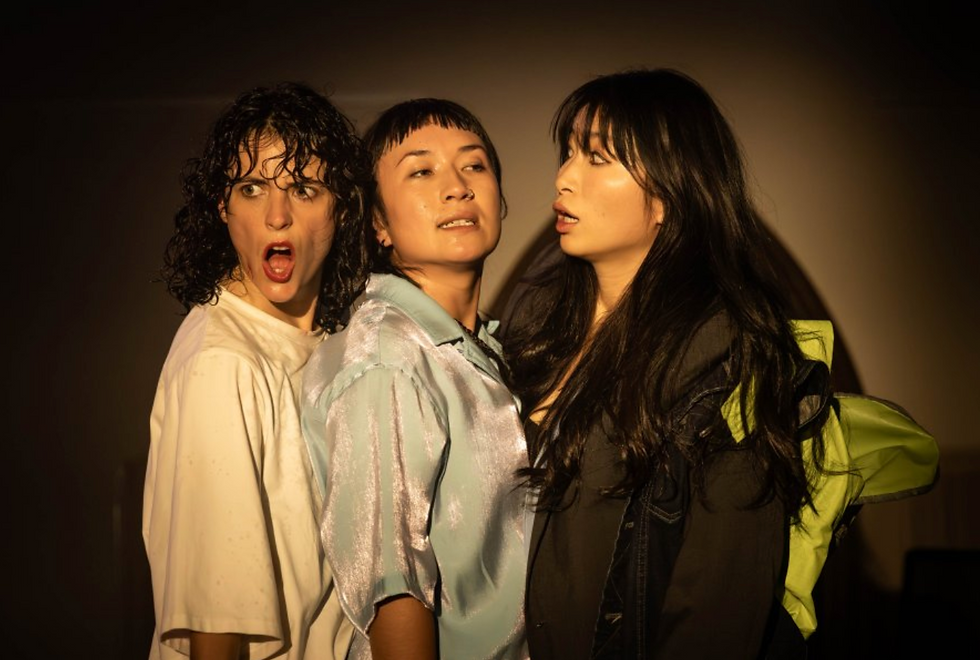Review: Control at Theatre Works Explosive Factory
- Theatre Travels

- Oct 24
- 4 min read
Review by Greg Gorton
Flatpack Theatre Company’s production of Keziah Warner’s Control is a beautiful, sometimes chaotic, and very human look at a possible future. It is a play with three distinct stories moving from near-future to distant, each with actors playing new (if somewhat linked) characters. With sci-fi designs reminiscent of the turn of the century, stories that range from Red Dwarf to Blade Runner, and an acting team that easily handles their multiple roles, this is certain to be a show many will love.
The design for Control is beautiful. Silvia Weijia Shao’s costume and set design evoke the low-budget visuals of Doctor Who, full of minimalistic white, opaque plastic flats, and cleverly maneuverable tables that transform the stage between the three stories. Space-suits are stylish, corporate outfits conformist, and the final design of the robot teacher feels very original while perfectly fitting in.
Sound designer, Lili Wymond, has also done an amazing job, with electro-pop music reminiscent of nineties sci-fi coming in and out of sound effects that are far from corny. However, one aspect of the sound design which sometimes failed to impress me personally was in the automated voices in the second story. While as much a directorial decision as a design one, there was often an impression of conversations being out of sync, and volume levels were un-necessarily high. These would not have been such an issue, however, if it were not for the general impression I had of such scenes by themselves.
The lighting design for control, done by Tomas Gerasimidis, was perfection. While other productions may have over-used the lighting effects for such a show, Gerasimidis offered only enough to have powerful impacts at the right moments. I suspect that the “white noise” moments will become a firm and positive memory in the minds of many audiences.
While there are ten characters on offer in Control, they are played here by only four people. Seon Williams, Faran Martin, Lachlan Herring, and Alex Duncan all do quite competent jobs, each quite comfortable at playing multiple distinct characters on one night. While perhaps having the advantage of more compelling characters to work with, Williams stood out to me for their ability to never let their roles become stereotypical or cliched, even when the circumstances would easily allow for it.
This production is very much a three-in-one, linked closely in theme but with only a tenuous link in narrative. Each is a look at the future, in which humans face the same ones we do today, but sometimes in space. It is a look at our lack of privacy, our strange relationships with technology, and our increasingly disconnected relationships with each other. While powerful in their messaging, these three plays are slightly weaker in story, and haphazard in presentation.
Act One, four celebrities are in a “big brother means pioneering spacemen” scenario that very much feels like something Ben Elton might write. It’s generally light-hearted, quite funny at times, but writer Keziah Warner is not afraid to use the time to explore the motivations and very human desires of the characters. Olivia Staaf’s direction here is at its best, with great use of the space and set pieces, dynamic activity, and development of chemistry between some of the actors. While I found the poor accents distracting (once I realised it wasn’t characters being asked to put them on), I found the characters to be compelling.
Act Two is where I most struggled as an audience member. The premise (a museum where your every past action is preserved for “only your” perusal) is something very close to home in a world where you are surveilled wherever you are in the CBD, where the metadata of your phone and internet is collected, and where this data is easily (and constantly) abused by those who have access to it. The characters are also interesting: the mercenary, the mother, and the early-stage replicant. However, while the basic story is easy to follow, the way that it is told is messy. Do not, I repeat, do not, pay attention to the “keyboards” or spend too much effort trying to work out exactly what is being said during the “phone call” scenes. It will only frustrate.
And then there is Act Three. If Act One was the Good One, and Act Two the Frustrating One, then Act Three is the Perfect One. It is the deepest and most engaging look at the difference between a computer and a human that I have experienced since watching Blade Runner all those years ago. Obviously, it is easy to compare this act to Blade Runner, and all audiences will. The difference lies in the very real relationship between human trainer and robot “teacher-to-be”. Stripped back almost entirely of set, props, anything that isn’t simply actor and audience, it is true theatre. This is the Keziah Warner writing that I rave about all the time to my friends, and Olivia Staaf has given the script life in the best way it could be done.
It’s a weird thing to ask a potential audience member: to sit through an hour of passable theatre in order to have twenty minutes of genius. That is what I’m doing. Fortunately, I’m not asking you to sit through bad theatre; many audiences are going to enjoy the entire night fully. For me, though, I’m always going to remember those last moments, and it is more than enough.





